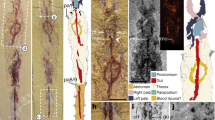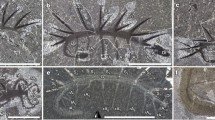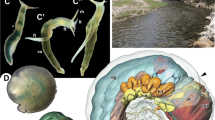Abstract
The origin and the position of the Clitellata in the phylogenetic system are the object of vigorous scientific debate. Since most extant Clitellata are either terrestrial or limnetic, the question arises which characters are specific adaptations to these environments and which are plesiomorphies taken from the annelid stem species. A promising approach is to study whether clitellate characters are present in terrestrial polychaetes as well. In fact, the terrestrial polychaetes Hrabeiella periglandulata Pizl & Chalupský, 1984 and Parergodrilus heideri Reisinger, 1925 have many features in common with the Clitellata, as does Stygocapitella subterranea Knöllner, 1934, which inhabits sandy beaches at the transition between the marine and terrestrial realms. These features include a prostomium lacking appendages, chaetae that are simple and short, an absence of parapodia, an epidermis without kinocilia, sensory cells with cilia that project only slightly beyond the cuticle or not at all, direct development, direct sperm transfer and eggs laid in cocoons. The nuchal organs so characteristic of polychaetes are either displaced into the body and reduced (S. subterranea, H. periglandulata) or absent (P. heideri). In H. periglandulata, the nervous system and the foregut also closely resemble those of the oligochaetes. These polychaetes are certainly not closely related and clearly do not belong to the Clitellata, as shown by their lack of a clitellum, the different structure and position of the reproductive organs and ultrastructural differences in the sperm. Hence their similarities to clitellates have most probably arisen by convergence. A hypothesis is presented explaining the evolution of the terrestrial polychaetes as a model for that of the Clitellata, documenting a primary terrestrial origin of the latter.
Similar content being viewed by others
References
Brinkhurst, R. O., 1984. The position of the Haplotaxidae in the evolution of oligochaete annelids. Hydrobiologia 115: 25–36.
Brinkhurst, R. O., 1994. Evolutionary relationships within the Clitellata: an update. Megadrilogica 5: 109–112.
Brinkhurst, R. O., & B. G. M. Jamieson, 1971. Aquatic Oligochaeta of the world. Oliver & Boyd, Edinburgh: 860pp.
Brinkhurst, R. O., & A. F. L. Nemec, 1987. A comparison of phenetic and phylogenetic methods applied to the systematics of Oligochaeta. Hydrobiologia 155: 65–74.
Bullock, T. H., 1965. Annelida. In T. H. Bullock & G. A. Horridge (eds), Structure and Function in the Nervous System of Invertebrates. Vol. I. Freeman and Company, San Francisco, U.S.A. 661–789.
Bunke, D., 1967. Zur Morphologie und Systematik der Aeolosomatidae Beddard, 1895 und Potamodrilidae nov. fam. (Oligochaeta). Zool. Jb. Syst. 94: 187–368.
Clark, R. B., 1969. Systematics and phylogeny: Annelida, Echiura, Sipuncula. Chemical Zoology 4: 1–68.
Eibye-Jacobsen, D. & R. M. Kristensen, 1994. A new genus and species of Dorvilleidae (Annelida, Polychaeta) from Bermuda, with a phylogenetic analysis of Dorvilleidae, Iphitimidae and Dinophilidae. Zool. Scr. 23: 107–131.
Eibye-Jacobsen, D. & C. Nielsen, 1996. The rearticulation of annelids. Zool. Scr. 25: 275–282.
Erséus, C., 1987. Phylogenetic analysis of the aquatic Oligochaeta under the principle of parsimony. Hydrobiologia 155: 75–89.
Ferraguti, M., 1984. The comparative ultrastructure of sperm flagella central sheath in Clitellata reveals a new autapomorphy of the group. Zool. Scr. 13: 201–207.
Giere, O., 1993. Meiobenthology. Springer, Berlin: 328 pp.
Graefe, U., 1977. Adenodrilus Graefe (in press) and Parergodrilus Reisinger two aberrant Annelida in forest soils. P. Cent. pir. Biol. exp. 9: 25.
Hartmann-Schröder, G., 1996. Annelida, Borstenwürmer, Polychaeta. In H. Schumann (ed.), Die Tierwelt Deutschlands 58, Gustav Fischer, Jena: 648pp.
Hessling, R., M.C. Müller & W. Westheide, 1999. CLSM analysis of serotonin-immunoreactive neurons in the central nervous system of Nais variabilis, Slavina appendiculata and Stylaria lacustris (Oligochaeta: Naididae). Hydrobiologia 406: 223–233.
Jamieson, B. G. M., 1992. Oligochaeta. In F. W. Harrison (ed.), Microscopic Anatomy of Invertebrates, Vol. 7 Annelida. Wiley-Liss, New York: 217–322.
Jans, W. & J. Römbke, 1989. Funde eines terrestrischen Polychaeten (Annelida) inWäldern Baden-Württembergs. Carolinea 47: 158–162.
Karling, T. G., 1958. Zur Kenntnis von Stygocapitella subterranea Knöllner und Parergodrilus heideri Reisinger. Ark. Zool. Stockh. 11: 307–342.
Knöllner, F., 1934. Stygocapitella subterranea nov. gen. nov. spec. Schr. naturw. Ver. Schles. Holst. 20: 68–72.
Kojima, S., 1998. Paraphyletic status of Polychaeta suggested by phylogenetic analysis based on the amino acid sequences of elongation factor-1_. Mol. Phylogenet. Evol. 9: 255–261.
Lasserre, P. & J. Renaud-Mornant, 1973. Resistance and respiratory physiology of intertidal meiofauna to oxygen-deficiency. Neth. J. Sea Res. 7: 290–302.
McHugh, D., 1997. Molecular evidence that echiurans and pogonophorans are derived annelids. Proc. natn. Acad. Sci. U.S.A. 94: 8006–8009.
Omodeo, P., 1997. History of Clitellata. Ital. J. Zool. 65: 51–73.
Orrhage, L., 1995. On the innervation and homologues of the anterior end appendages of the Eunicea (Polychaeta), with a tentative outline of the fundamental constitution of the cephalic nervous system of the polychaetes. Acta Zool. (Stockh.) 76: 229–248.
Perrier, M. E., 1872. Historie naturelle du Dero obtusa. Arch. Zool. exp. gén. Paris 1: 65–97.
Pizl, V. & J. Chalupský, 1984. Hrabeiella periglandulata gen. et. sp.n. (Annelida) – a curious worm from Czechoslovakia. Vest. cs. Spolec. zool. 48: 291–295.
Purschke, G., 1986. Ultrastructure of the nuchal organ in the interstitial polychaete Stygocapitella subterranea (Parergodrilidae). Zool. Scr. 16: 13–20.
Purschke, G., 1987. Anatomy and ultrastructure of ventral pharyngeal organs and their phylogenetic importance in Polychaeta (Annelida). III. The pharynx of the Parergodrilidae. Zool. Jb. Anat. 115: 331–362.
Purschke, G., 1993. Structure of the prostomial appendages and the central nervous system in the Protodrilida (Polychaeta). Zoomorphology 113: 1–20.
Purschke, G., 1997. Ultrastructure of nuchal organs in polychaetes (Annelida) – New results and review. Acta Zool. (Stockh.) 78: 123–143.
Purschke, G. & A. B. Tzetlin, 1996. Dorsolateral folds in the polychaete foregut: structure, prevalence and phylogenetic significance. Acta Zool. (Stockh.) 77: 33–49.
Purschke, G., W. Westheide, D. Rohde & R. O. Brinkhurst, 1993. Morphological reinvestigation and phylogenetic relationship of Acanthobdella peledina (Annelida, Clitellata). Zoomorphology 113: 91–101.
Reisinger, E., 1925. Ein landbewohnender Archiannelide – zugleich ein Beitrag zur Systematik der Archianneliden. Z. Morph. Ökol. Tiere 3: 197–254.
Reisinger, E., 1960. Die Lösung des Parergodrilus-Problems. Z. Morph. 48: 517–544.
Riser, N. W., 1980. The aberrant Polychaete Stygocapitella from some American beaches. Wasman J. Biol. 38: 10–17.
Riser, N.W., 1984. General observations on the intertidal interstitial fauna of New Zealand. Tane 30: 239–250.
Rota, E., 1997. First Italian record of the terrestrial polychaete Parergodrilus heideri Reisinger, with anatomical and ecological notes. Ital. J. Zool. 64: 91–96.
Rota, E., 1998. Morphology and adaptations of Parergodrilus Reisinger and Hrabeiella Pizl & Chalupský, two enigmatic soil-dwelling annelids. Ital. J. Zool. 65: 75–84.
Rota, E. & P. Lupetti, 1996. An ultrastructural investigation of Hrabeiella Pizl & Chalupský, 1984 (Annelida). I. Chaetae and body wall organization. Hydrobiologia 334: 229–239.
Rota, E. & P. Lupetti, 1997. An ultrastructural investigation of Hrabeiella Pizl & Chalupský, 1984 (Annelida). II. The spermatozoon. Tiss. Cell 29: 603–609.
Rouse, G. W. & K. Fauchald, 1995. The articulation of annelids. Zool. Scr. 24: 269–301.
Rouse, G. W. & K. Fauchald, 1997. Cladistics and polychaetes. Zool. Scr. 26: 139–204.
Schmidt, P., 1970. Zonation of the interstitial polychaete Stygocapitella subterranea (Stygocapitellidae) in european sandy beaches. Mar. Biol. 7: 319–323.
Schmidt, P., 1972. Zonierung und jahreszeitliche Fluktuationen des Mesopsammons im Sandstrand von Schilksee (Kieler Bucht). Mikrofauna Meeresboden. 10: 6–60.
Schwank, P., 1981. Turbellarien, Oligochaeten und Archianneliden des Breitenbaches und anderer hessischer Mittelgebirgsbäche. II. Die Systematik und Autökologie einzelner Arten. Arch. Hydrobiol. Suppl. 62: 86–147.
Siewing, R., 1953. Morphologische Untersuchungen am ‘Kopf’ der Pisionidae (Pisione puzae nov. spec. Annelida, Polychaeta). Zool. Anz. 150: 298–313.
Storch, V. & U. Welsch, 1972. Ultrastructure and histochemistry of the integument of air-breathing polychaetes from mangrove swamps of Sumatra. Mar. Biol. 17: 137–144.
Tietze, F., 1968. Untersuchungen über die Beziehungen zwischen Bodenfeuchte und Carabidenbesiedlung in Wiesengesellschaften. Pedobiologia 8: 50–58.
Timm, T., 1981. On the origin and evolution of aquatic Oligochaeta. Eesti NSV Tead. Akad. Toim. (Biol.) 30: 174–181.
Verger-Bocquet, M., 1992. Polychaeta: Sensory structures. In F. W. Harrison (ed.), Microscopic Anatomy of Invertebrates, Vol. 7 Annelida. Wiley-Liss, New York: 181-196.
Westheide, W., 1990. Polychaetes: Interstitial families. In D. M. Kermack & R.S.K. Barnes (eds), Synopsis of the British Fauna 44. Universal book services/Dr W. Backhuys, Oegstgest: 152pp.
Westheide, W., 1997. The direction of evolution within Polychaeta. J. Nat. Hist. 31: 1–15.
Westheide, W. & M. C. Müller, 1996. Cinematographic documentation of enchytraeid morphology and reproductive biology. Hydrobiologia 334: 263–267.
Westheide, W. & G. Purschke, 1988. Organism processing. In R. P. Higgins & H. Thiel (eds), Introduction to the Study of Meiofauna. Smithsonian Institution Press, Washington. 146–160.
Westheide, W., D. McHugh, G. Purschke & G. Rouse, 1999. Systematization of the Annelida: different approaches. Hydrobiologia 402: 291–307.
Author information
Authors and Affiliations
Rights and permissions
About this article
Cite this article
Purschke, G. Terrestrial polychaetes – models for the evolution of the Clitellata (Annelida)?. Hydrobiologia 406, 87–99 (1999). https://doi.org/10.1023/A:1003780032497
Issue Date:
DOI: https://doi.org/10.1023/A:1003780032497




